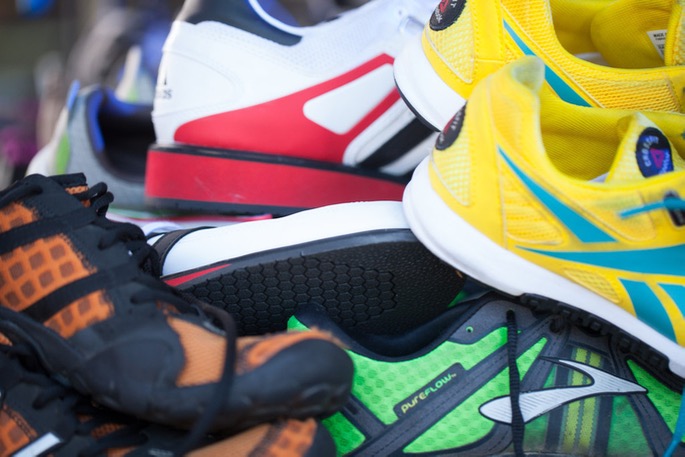Video Transcript:
I wanted to take some time today to talk about proper footwear. First off, I’m going to qualify that this content is ultimately geared towards what is going to make a general health and fitness client’s strength training the MOST effective. For us at MSP Fitness when it comes to strength, we’re generally thinking of movements that takes place on the lifting platform, and thus the type of shoe is going to help make that lift as successful as possible. The conversation that we are going to have is based off three common shoe types we see:
1. The Running Shoe. (mushy, gummy sole; flexible; arch support; minimal heel cup)
2. The Minimalist. (old school Chuck Taylor, Reebok Nano, flat sole, low profile)
3. The Weightlifting Shoe. (rigid, uni-tasker, raised heel, solid heel cup)
I think it is important to ask the question, why does it matter? Why have 50 different pairs of shoes to match every outfit and every task? The image that comes to my mind is someone attempting a 100m dash in high heels. Not very effective. In a variety of situations, it is the proper footwear that can help facilitate better movement, better positions, and better results for that athlete or client. For those of us concerned with strength and resistance training, this means more weight on a barbell in turn providing more gains of strength.
When we’re discussing footwear, we are talking about being grounded to the floor. When we interface with different shoe choices, our ability or stability in a given environment is directly affected. Our thought is how can the proper shoe choice set someone up for success, taking into account that a majority of training output is expressed in force through the feet or floor.
The Running Shoe:
This takes us to our first shoe, undoubtedly the most common of shoe choice you’ll see in your average gym, the Running Shoe. Let me reiterate the fact that this shoe is for running. When individuals use it in a strength training environment, not only will lifting in the shoe reduce it’s life expectancy for the purpose of running, but we’d equate it to lifting on a waterbed. Because of the shoe’s gummy sole, I can confidently say this isn’t going to help you very much in a strength training realm, so let’s talk about some shoes that will.
The Minimalist Shoe:
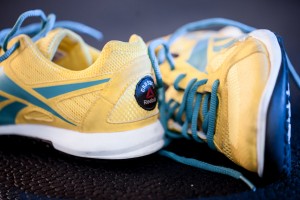 In contrast to the running shoe, you’re going to see both a flatter sole and little to no “mush” between the feet and the floor in a Minimalist Shoe. With the wearer possessing reasonable ankle mobility, the minimalist shoes connection to the floor and versatility are two of the top reasons that we’d consider them an excellent option for training. In a mixed-model training session where one might have barbell work on the front end, coupled with running and bodyweight movements within the same training, if you are blessed with adequate ankle mobility, the minimalist shoe might actually be the only footwear you’ll ever need. Because of your good mobility, you won’t be limited in any one movement. While we might agree that your favorite Nike Romaleos or AdiPowers would be ideal for the weightlifting part of the training session, running in them is impossible. Overall, if you have good mobility and a need for versatility the Minimalist shoe is a do it all option.
In contrast to the running shoe, you’re going to see both a flatter sole and little to no “mush” between the feet and the floor in a Minimalist Shoe. With the wearer possessing reasonable ankle mobility, the minimalist shoes connection to the floor and versatility are two of the top reasons that we’d consider them an excellent option for training. In a mixed-model training session where one might have barbell work on the front end, coupled with running and bodyweight movements within the same training, if you are blessed with adequate ankle mobility, the minimalist shoe might actually be the only footwear you’ll ever need. Because of your good mobility, you won’t be limited in any one movement. While we might agree that your favorite Nike Romaleos or AdiPowers would be ideal for the weightlifting part of the training session, running in them is impossible. Overall, if you have good mobility and a need for versatility the Minimalist shoe is a do it all option.
The Weightlifting Shoe:
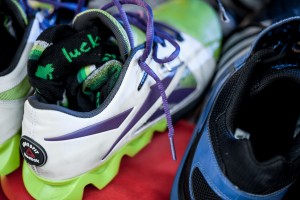 Let’s move on to our last piece of footwear, the famous Weightlifting Shoe. The role of these shoes can clearly be determined by their name. Just like the running shoe is for runners, competitive weightlifters will exclusively wear WL Shoes. I will additionally say that for an individual pursuing general health and fitness, these kicks might be a little over relied upon. As mentioned above, mobility, or lack thereof, is something to think about when considering a weightlifting shoe viability in your arsenal of shoe choices. They aren’t the end all be all for every lifting scenario and person. With that said, let’s look at the benefits.
Let’s move on to our last piece of footwear, the famous Weightlifting Shoe. The role of these shoes can clearly be determined by their name. Just like the running shoe is for runners, competitive weightlifters will exclusively wear WL Shoes. I will additionally say that for an individual pursuing general health and fitness, these kicks might be a little over relied upon. As mentioned above, mobility, or lack thereof, is something to think about when considering a weightlifting shoe viability in your arsenal of shoe choices. They aren’t the end all be all for every lifting scenario and person. With that said, let’s look at the benefits.
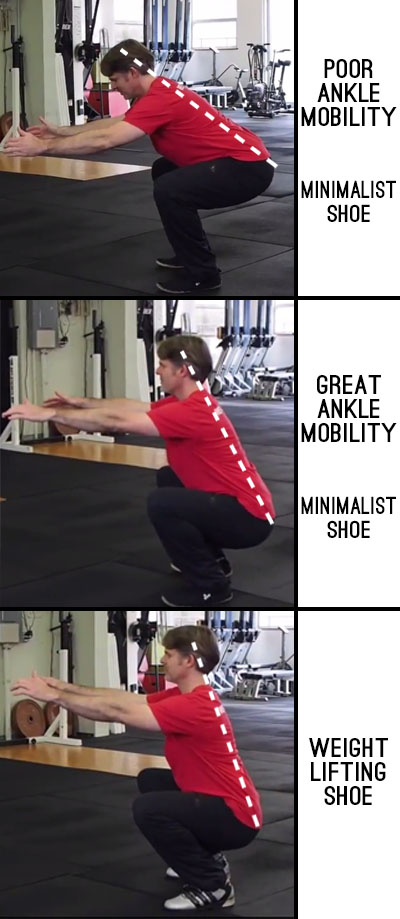 First and foremost, the shoes is incredibly rigid, giving the sensation of lifting in cement. The second, and probably the most distinguishing characteristic of all weightlifting shoes, is their raised heels. It’s this raised heel that affords the wearer a ‘gift’ of extra mobility/range of motion when performing certain movements, most notably squats. If your positions are naturally inhibited by your ankle’s inability to translate forward (dorsiflexing to end range), that will directly affect the amount of weight you can load, ultimately reducing your ability to get strong. In all my years of coaching, analyzing and assessing hundreds of clients, I’ve seen some pretty jacked up ankles.
First and foremost, the shoes is incredibly rigid, giving the sensation of lifting in cement. The second, and probably the most distinguishing characteristic of all weightlifting shoes, is their raised heels. It’s this raised heel that affords the wearer a ‘gift’ of extra mobility/range of motion when performing certain movements, most notably squats. If your positions are naturally inhibited by your ankle’s inability to translate forward (dorsiflexing to end range), that will directly affect the amount of weight you can load, ultimately reducing your ability to get strong. In all my years of coaching, analyzing and assessing hundreds of clients, I’ve seen some pretty jacked up ankles.
Mobility Considerations:
If you look at the images, poor ankle mobility forces my squatting position to be hips backwards, increasing my torso angle forward to balance. This means I’m working overly hard to simply balance myself, versus working to lift the load. The pitch of my body (marked by the dotted white line) is incredibly inefficient when compared to a more ideal, upright torso. For front, back, or any loaded squatting, an upright torso keeps the weight over the middle of the base, allowing for more direct patterns of force. In the “poor” front squat image, you’ll see how far forward the bar is, relative to my footprint (shown by the green line). When compared to the front squat image in weightlifting shoes, it’s clear to see the center of that bar directly on top of my mid-foot, giving me a direct downward force, equating to a more efficient lift. This is a great example of where proper footwear, like a weightlifting shoe, is going to put an athlete or client in better positions, making them more successful and far safer while squatting.
Conclusion:
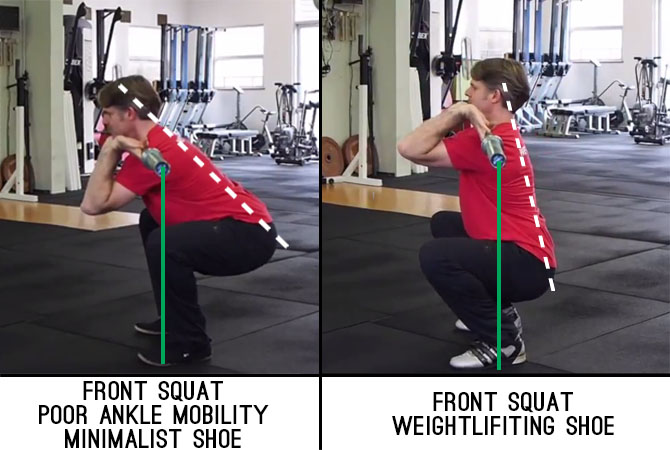 At this point now you might be asking, so if I have good ankles and my sport isn’t weightlifting, do I even need weightlifting shoes? As stated above, technically speaking no. Get yourself in a good minimalist shoe and you are likely covered for most of your training needs. With that said, I would still likely put a strength focused client in weightlifting shoes because they’re going to be more stable, more confident, and thus able to put more weight on the bar.
At this point now you might be asking, so if I have good ankles and my sport isn’t weightlifting, do I even need weightlifting shoes? As stated above, technically speaking no. Get yourself in a good minimalist shoe and you are likely covered for most of your training needs. With that said, I would still likely put a strength focused client in weightlifting shoes because they’re going to be more stable, more confident, and thus able to put more weight on the bar.
Wrapping up, we can look back and see that the path towards choosing the best shoe isn’t as straight as you might’ve thought. I hope we can all conclude that running shoes, when considered for things other than running, can be taken off the table. Both minimalist and weightlifting shoes provide a ton of value. Considerations need to be made for both the shoe’s training application and the individual’s ankle mobility before “lacing up.”
– Written by Michael (MSP) Pilhofer

